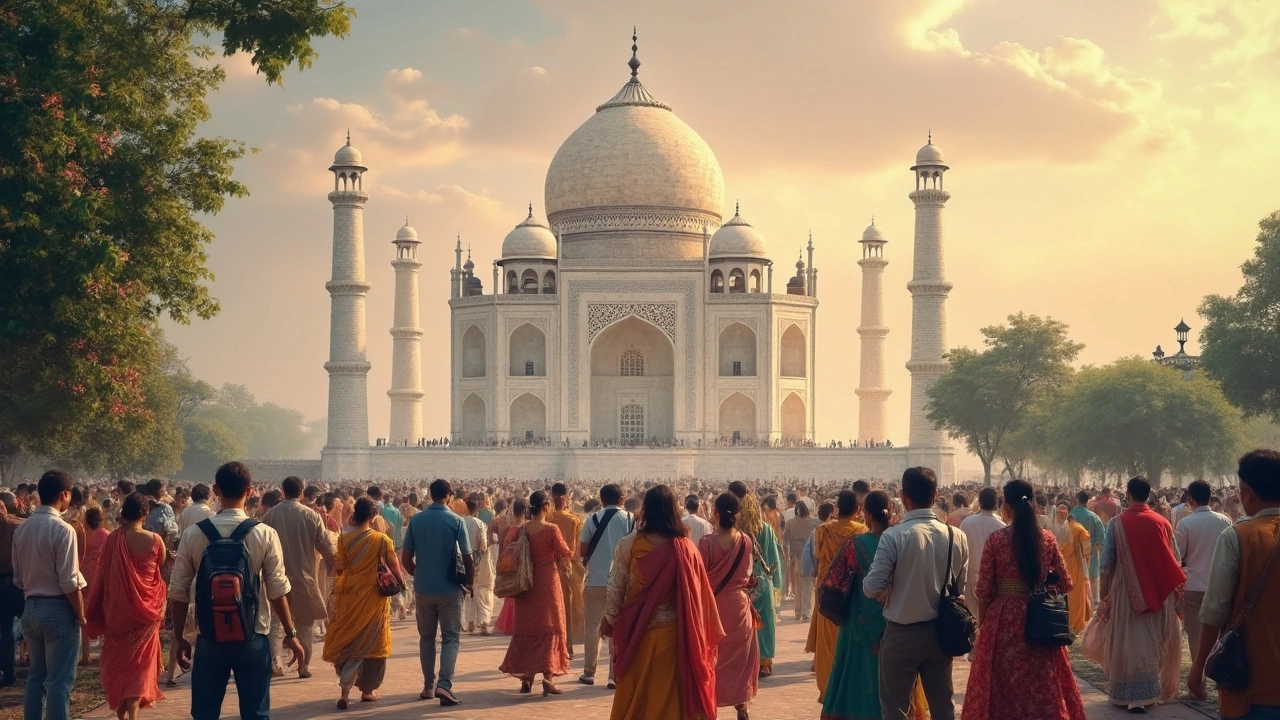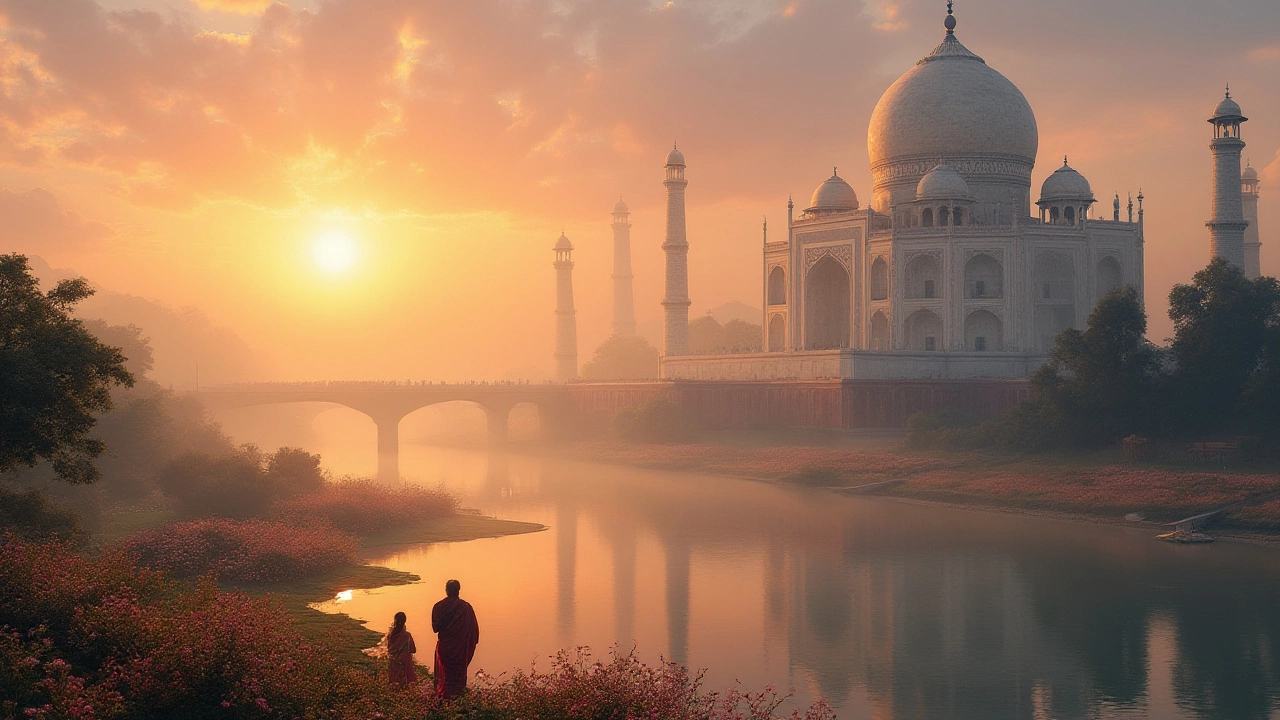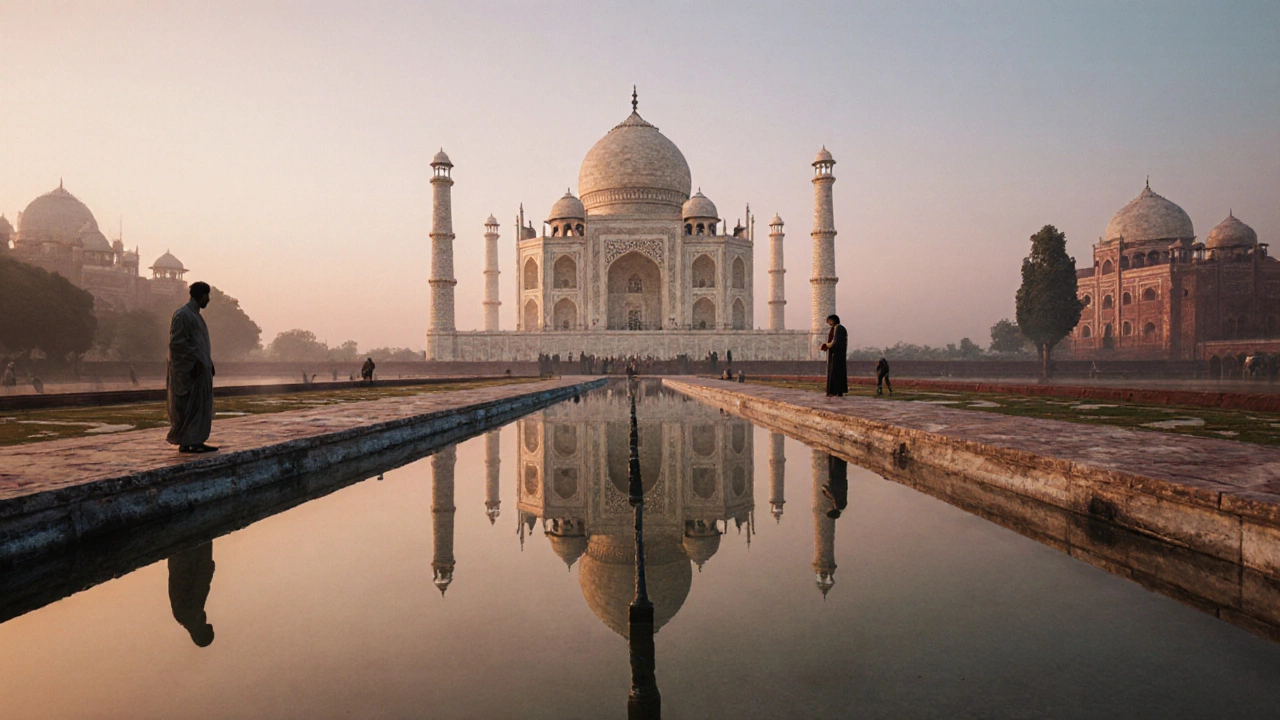Why is Agra Famous For? Iconic Sights, Tastes, and Stories
You know Agra for the Taj Mahal. But that's just one layer. The city turns up surprises for anyone willing to look past the postcard views. Here, history lives in back alleys, centuries-old recipes, and markets where time feels stuck in the past. Want to know why so many travelers put Agra on their bucket list? It's not just about getting that photo in front of white marble.
Agra can blow your mind if you ask the right questions and try the right samosa. It's not just a quick stop between Delhi and Jaipur. This place serves up stories, reminders of the Mughal empire, and food that might actually spoil you for other cities. If you crave layered history, bold flavors, and a few offbeat memories, Agra has you covered.
It's easy to get stuck in the crowd at the Taj Mahal and miss the rest. But stick around, let yourself wander, and you'll find more than you expected. Ready for the real Agra – not the cookie-cutter tour version, but the city that feeds locals and tells stories without holding back? You're in the right spot.
- The Taj Mahal and Its Stories
- Agra Fort: More Than Red Walls
- Mughal Legacy and Hidden Corners
- Local Bites: Food You Should Not Miss
- Shopping the Old City
- Practical Tips for Your Agra Trip
The Taj Mahal and Its Stories
Let’s get the big one out of the way. The Taj Mahal isn’t just another monument. Built in the mid-1600s by Shah Jahan for his wife Mumtaz Mahal (yeah, true love can build a legacy), it’s a giant marble reminder of the Mughal obsession with beauty and design. Everyone calls it a wonder, but when you walk in and see all the geometric inlays and symmetry up close, you’ll get why. Flip through any traveler’s photos in North India—this place always shows up.
Most people don’t realize the Taj isn’t pure white. Its marble actually shifts color—rosy at sunrise, cream during the day, and cool blue-gray by moonlight. That wasn’t an accident; Mughal architects planned it. More than 20,000 workers (yep, that many) spent over two decades turning cartloads of marble from Rajasthan into a single, jaw-dropping tribute.
- Opens: Sunrise (when it’s quietest and the light is unreal)
- Closed: Fridays (for prayers)
- Ticket tips: Buy online to skip crazy lines, and bring ID
Next up, the famous stories. There are the classics—that Shah Jahan lost everything and spent his last years in Agra Fort, looking across the river at the Taj, missing his wife. If you spot tour guides talking about him planning a black marble Taj across the Yamuna River, be skeptical. No good proof exists, but the rumor makes for a great story.
| Facts | Details |
|---|---|
| Construction Dates | 1632 to 1653 |
| Marble Used | White marble from Makrana, Rajasthan |
| Height | 73 meters (main dome) |
| Visitors per year | Over 6 million |
| UNESCO World Heritage Site | Since 1983 |
If you want a quieter photo and a good story for your friends, show up for sunrise or, even better, plan a night viewing. Only five nights a month—the two before and after the full moon and the full moon itself—you get to see the Taj in a totally different light. You’ll need to book tickets in advance though, and only a set number go in at night, so plan ahead.
Quick tip: Security is tight. Don’t bring food, tripods, or fancy gadgets. Stick to your phone or a basic camera and go light. Water bottles are only allowed if they’re small. If you want a fun ‘local’ shot, try viewing the Taj from Mehtab Bagh, the garden right across the river, near sunset.
Agra Fort: More Than Red Walls
People talk about the Taj Mahal like it’s the only game in town, but Agra Fort has been holding the city’s secrets for way longer. Built out of red sandstone by Emperor Akbar in 1565, this mammoth structure feels less like a single monument and more like a mini city. You can walk for over two kilometers along its massive walls. No joke—this place used to be the real seat of power when the Mughal emperors were calling the shots in North India.
Don’t let the outside fool you. Step inside and it’s another world: marble palaces, courtyards, royal baths, gardens, and rooms where deals—and betrayals—went down. Shah Jahan, the guy behind the Taj Mahal, actually got locked up here by his own son. For eight years, he could only stare at his masterpiece through a distant window. Tough luck, right?
Want actual details about what you’ll see? Here’s a rundown of some can’t-miss spots inside the fort:
- Diwan-i-Am (Hall of Public Audience): Where the emperor would sort out everyday matters, with crowds packed in to get a word in.
- Diwan-i-Khas (Hall of Private Audience): Where top-secret royal business happened, usually over some heavy jewels and harder stares.
- Jahangiri Mahal: A palace built for Akbar’s favorite wife. This one is all dense sandstone, traditional lattice work, and serious Mughal style.
- Musamman Burj: That legendary tower where Shah Jahan spent his last years with a view of the Taj Mahal.
Visiting early in the morning or late afternoon keeps you away from the noon crowds and the heat. There’s decent English audio guides, but hiring a local guide is worth it—stories land better when they’re personalized.
Here’s a quick breakdown of Agra Fort stats:
| Fact | Detail |
|---|---|
| Built | 1565–1573 AD |
| Primary Material | Red sandstone, with some marble work |
| UNESCO Status | World Heritage Site (since 1983) |
| Length of Walls | 2.5 km |
| Historical Use | Main residence of Mughal emperors until 1638 |
| Entry Fee (2025) | ₹50 (Indians), ₹650 (foreigners) |
If you want to really understand why Agra was a big deal way before anyone heard of Instagram, Agra Fort is where you need to go. Skip it, and you’ll miss the real story behind those famous white domes just down the road.
Mughal Legacy and Hidden Corners
Agra isn’t just about the big shots like the Taj or Agra Fort. Every corner whispers about the days when the city was the power center for Mughal emperors. You can still find Muslim tombs, stepwells, and gardens that haven’t made the Instagram rounds. These places keep the city’s Mughal vibe alive and set Agra apart from every other town in North India.
Mehtab Bagh is a must if you want to see the Taj Mahal without the crowds. This riverside garden directly faces the Taj, giving you a view that’s both peaceful and photogenic—locals actually prefer it to the main site. Nearby, the Tomb of Itimad-ud-Daulah (known as the “Baby Taj”) shows off intricate marblework and gives you a taste of Mughal family feuds. This spot is a lot less chaotic, so you actually have time to look at the carvings and mosaics.
The Mughal legacy pops up in unexpected pockets:
- Agra has old havelis (mansions) in Kinari Bazaar where merchants once hosted royal parties.
- Chini Ka Rauza, covered in colorful glazed tiles, is a weird blend of Persian and Indian styles—almost nobody goes there, so it feels like your own secret find.
- The old Mughal-era mosques, like Jama Masjid near the railway station, still draw locals for prayers and Friday chats over chai.
One tip—don’t just stick to the main drag. Hire a rickshaw or take a short walk through lesser-known lanes, especially around Tajganj and the old market areas. These backstreets hide Mughal-era wells, bits of old city walls, and shrines locals still visit every week. If you're curious (and polite about photos), some families will even show off their old courtyards and hand you a cup of sweet tea.
So even if the guidebooks skim past these places, know that real Agra is still steeped in its Mughal story—it just asks you to pay a little closer attention.
Local Bites: Food You Should Not Miss
If you skip Agra’s food scene, you’re honestly missing half the story. Forget meal plans at big hotels; real Agra lives in its street food stalls, old sweet shops, and crowded local diners. Here’s the honest truth: people travel across states for a box of Agra petha or a plate of hot bedai. You should too, even if you don’t usually chase food trends.
- Agra Petha: This weird-looking, see-through candy is made from ash gourd. You’ll spot racks stacked with petha everywhere. Go for the classic dry variety or try the newer mango, chocolate, or paan flavors. Don’t leave without tasting at least one. Sadar Bazaar and Panchhi Petha stores are the hotspots.
- Bedai & Jalebi: Locals eat this crunchy, spicy breakfast almost daily. Bedai is a puffy deep-fried bread stuffed with spiced lentils, paired with runny potato curry and a swirl of sticky-sweet jalebi. Find it sizzling at Deviram Sweets, early mornings are best before the crowds clean them out.
- Mughlai Cuisine: Rich, meaty dishes are Agra’s old-school comfort food. Try mutton korma, chicken tikka, or keema naan. Most tiny diners (locally called dhabas) along Fatehabad Road or in Taj Ganj serve up unforgettable plates. Don’t expect fancy settings, just big flavors.
- Chaat: Agra’s chaat corners pack serious punch. Go for dahi bhalla, aloo tikki, or spicy golgappas. Sadar Bazaar is your best bet if you want the real deal.
- Dalmoth: This is Agra’s crunchy snack mix—think fried lentils, nuts, and spices. It’s a must-buy for the road, and even better with hot chai in the evening.
| Dish | Location | Best Time |
|---|---|---|
| Petha | Panchhi Petha, Sadar Bazaar | All Day |
| Bedai & Jalebi | Deviram Sweets, Agra Cantt | Morning (7am-10am) |
| Mughlai Curries | Dhabas on Fatehabad Road | Lunch, Dinner |
| Chaat | Sadar Bazaar | Evening (5pm-9pm) |
| Dalmoth | Panchhi Dalmoth, Gopal Das Pethe Wala | All Day |
One quick tip: Trust the crowds. If you see a line, there’s probably a good reason. Skip the flashy restaurants and aim for places packed with locals. Those tiny shops have been cranking out the city’s best flavors for generations. Bring an appetite, and maybe some extra napkins. You’re going to need them.
Shopping the Old City
If shopping is on your mind, Agra’s old city streets can turn even the most casual window-shopper into a full-fledged bargain hunter. The main spots that get all the buzz are Sadar Bazaar, Kinari Bazaar, and Rawatpara. Each one brings something different to the table. If your trip is short, hit up Sadar Bazaar first—it’s close to Cantonment railway station and packs options from leather goods to handicrafts. Agra is known for its leather shoes, bags, and belts, and you’ll spot shops everywhere competing for your attention. Tip: Check for genuine leather by pressing with your thumb—real leather leaves a mark for a second or two, while fake stuff bounces back quickly.
Kinari Bazaar screams color and chaos. This is where wedding sarees, jewelry, and glass bangles line the shops in tiny alleyways. Don’t be shy about bargaining. Most shopkeepers expect it, and you’ll probably walk out paying half the original asking price—especially if you buy more than one thing. Foodies, don’t ignore the petha stalls around here. Petha is Agra’s signature sweet (kind of like a soft candy made from ash gourd), and you’ll see it everywhere. Try the classic white petha, or go wild with flavors like mango or paan.
Take a stroll through Rawatpara if you want to dig into the city’s old spice and dry fruit markets. The smells will make you hungry, and honestly, there’s no shame in picking up a ready-to-eat snack while you’re hunting for souvenirs. Also, if you’re into marble work (think tiny replicas of the Taj Mahal), this is where you’ll find the best deals. Watch out for the difference between hand-carved work and the cheap imitations churned out in bulk— craftspeople usually love showing you how the work is done.
Want to see how prices stack up on local specialties? Here’s a snapshot:
| Item | Typical Price Range (INR) | Tips |
|---|---|---|
| Leather Shoes | 500-2500 | Check for real leather and comfortable fit |
| Marble Souvenirs | 200-2000 (small items) | Hand-carved pieces cost more |
| Petha (500g) | 80-150 | Buy from a busy, popular store for freshness |
| Glass Bangles (set) | 50-300 | Inspect for chips or cracks |
Bargaining saves you money in Agra. Don’t rush. Shops open late and stay busy into the night, especially on weekends. And leave some extra room in your suitcase—trust me, you’ll end up with more than you planned.
Practical Tips for Your Agra Trip
Planning a visit to Agra? Here’s the stuff that actually matters when you’re on the ground. Little details can save you a lot of headaches here. Don’t just show up at the Agra railway station and hope for the best—Agra rewards the traveler who makes smart choices.
First up, let’s talk timing. The best months to visit are October to March. The weather is cooler, which makes exploring way easier. Monsoon season (July to September) turns things muggy, so unless you love sweating it out, avoid that window. The Taj Mahal is closed every Friday for prayers. You might want to plan your schedule around that, because a lot of people don’t realize until they’re at the gate.
Another pro tip: Buy tickets online in advance! You’ll skip one of the two lines at the Taj Mahal and sometimes even grab a better deal. And remember, bags are a hassle. Security at major sites, especially the Taj, is tight. Seriously, travel light—a phone, wallet, and water are all you need inside.
Agra is a tourist magnet, so scams happen. Ignore so-called ‘guides’ hanging around entrances. Instead, get an official guide from inside the monument or use a reliable app with good reviews. Metered rickshaws are a rare species; bargain the fare before hopping in. If you’re coming from Delhi or Jaipur, the fastest way in is the Gatimaan Express train—less than two hours from Delhi. Always double check train timings. Trains love to run late.
Here’s a quick reference with practical info you’ll want to know:
| Site | Entry Fee (INR, Foreigners) | Opening Hours | Closed On |
|---|---|---|---|
| Taj Mahal | 1,100 (includes shoe covers & water) | 6 AM - 6:30 PM | Friday |
| Agra Fort | 650 | 6 AM - 6 PM | Open daily |
| Mehtab Bagh | 300 | 6 AM - 6 PM | Open daily |
If food is your thing, only eat at busy stalls with lots of locals. It means the food turns over fast and is less likely to cause trouble. Carry bottled water. The tap water? Just don’t.
- Carry cash, but not too much. ATMs are easy to find, but some machines can be finicky.
- Dress comfortable and conservative. Shorts and tanks are fine for tourists, but respect temples and mosques—it helps you blend in better.
- Keep Google Maps or maps.me handy. Agra’s old city is a maze.
- If you want fewer crowds at the Taj, get there for sunrise. Not only is the light perfect, but even the locals aren’t up yet.
One last thing—double check hotel reviews and choose places close to the sights. Not every rickshaw ride is fun, especially late at night. A bit of upfront planning can give you many more wow moments in Agra—not just the obvious ones.


